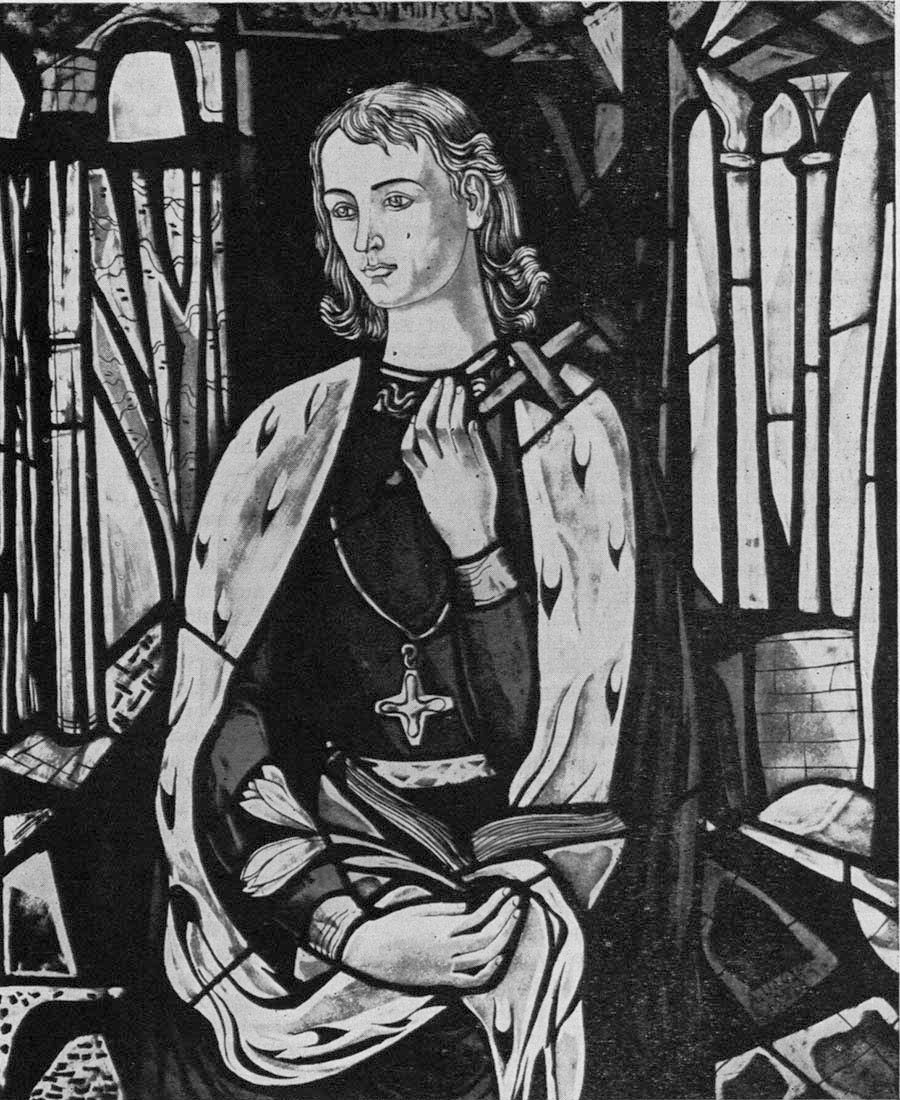
March, 1958 Vol. 4, No. 1
Managing Editor P. V. Vygantas
 |
www.lituanus.org |
| Copyright
© 1958 Lithuanian
Students Association, Inc. March, 1958 Vol. 4, No. 1 Managing Editor P. V. Vygantas |
|
KNIGHT ON A WHITE STEED
500 ANNIVERSARY OF THE BIRTH OF ST. CASIMIR
SIMAS SUŽIEDĖLIS,
Simas Sužiedėlis, a noted Lithuanian historian, is the author of numerous historical books. He studied history and philosophy at Kaunas and Riga and then taught at the University of Vytautas the Great at Kaunas. During 191,019H he was the secretary general of the Lithuanian Academy of Sciences. Currently, he is the editor of the semi-weekly "Darbininkas" in Brooklyn, N. Y.
 |
| St Casimir Adolfas Valeška |
During the 12th and 13th centuries the expanding Lithuanian state suceeded in establishing control over the source of the Dauguva (Duna) River and the city of Polock. The city became a btss for Lithuanian expeditions to the east that reached Moscow and Tver. Not until early in the 16th century did the Duchy of Moscow become strong enough to force the Lithuanians back toward the west. In 1518 the Muscovites approached the city of Polock and besieged its castle, which stood on the right bank of the Duna.
A small Lithuanian army hurried to the relief of the besieged castle from the left bank of the river. But the river was flooded, so it was decided to ride along its bank in search of a ford by which the opposite side could be reached. Speed was of the essence, since the castle might fall before help reached it. Suddenly a knight on a white steed appeared in front of the Lithuanian army; beckoning the army to follow him, he plunged into the river and rode across. The army did follow, and after a safe crossing it attacked the Muscovites and dispersed them. The siege was raised; after the battle, however, when the soldiers looked around for their unexpected leader, he could not be found. As he had appeared, so he had disappeared, without leaving a trace. Who was this strange warrior? Where had he come from, and whence had he gone?
The only explanation the witnesses could find for this strange apparition was that Prince Casimir had miraculously reappeared. He had died 34 years before and had been buried in Vilnius Cathedral. He had been known for his saintliness, and his brother, King Sigismund (15061548), and Albert, Bishop of Vilnius, had already taken steps toward Casimir's canonization. The canonization trial accepted Casimir's appearance at Polock as authentic, and it is now mentioned in the Roman Catholic priests' breviary.
St. Casimir was born in the old Polish capital of Krakow on October 3, 1458. His father was Casimir, Grand Duke of Lithuania (14401447), who had become King of Poland upon the death of his brother Vladislavas in battle against the Turks. From 1447 to 1492, Casimir ruled both Lithuania and Poland. Casimir had married Elizabeth, daughter of the Holy Roman Emperor Albrecht II; they raised 11 children in all six sons and five daughters. Saint Casimir was the third child and second son. Since Elizabeth had claims to the thrones of both Bohemia and Hungary, the eldest son, Vladislavas, ascended the Bohemian throne while in 1471 Casimir, at the age of 13, was sent with a Polish army to conquer Hungary. This expedition failed, and he became heir to the Polish and Lithuanian thrones
In Krakow he was tutored by the famed Polish historian Canon John Dlugosh. who referred to his pupil as "a youth of rare talent and nobility." Another of his teachers, Philip Callimach Buona-corsi ,an Italian humanist, remembered him as "a saintly youth" ("divus adolescens"). It is said in a Prussian chronicle that the prince was "very virtuous and intelligent" and that "the people spoke only good" of him. And in his daily life he was noted for his piety, his restraint and his great virtue. This became especially noticeable when he began to participate in affairs of state.
When Casimir was 17 years old he accompanied his father, the king, on his journeys throughout the kingdom, attending congresses and conferences, receiving foreign diplomats and marching with the army. For about two years (14811483) he administered Poland himself, residing at Radom. He managed the chancellery, the courts, the treasury and the administration. He was careful in his work and became noted for his thriftiness; he was able to pay many debts his father had contracted. He restored good relations with the Holy See, and was extremely concerned about the wars with the Turks, who in 1453 had occupied Constantinople and abolished the Byzantine Empire. At his initiative, his uncle's expedition against the Turks, in which Vladislavas had died in 1444 in battle at Varna, was chronicled.
In 1475, with his father, St. Casimir visited Lithuania for the first time. He made five further journeys, to Vilnius, Trakai, Gardinas (Grodno), Brasta (Brest Litovsk) and other towns. In the last year of his life (14831484), he acted for his father in Vilnius. He was already ill with tuberculosis, caused in all probability not only by his weak constitution but also by his ascetic way of life. In Vilnius he devoted himself wholly to prayer, fasting and charitable works. During his canonization trial he was called "guardian and father of the poor," and his great devotion to the Blessed Virgin and his compassion for the crucified Christ were noted. St. Casimir's greatest virtue was chastity, and he preserved it throughout his life. He died on March 4, 1484, at Gardinas and was buried in Vilnius Cathedral, where a chapel was erected in his honor.
Immediately after St. Casimir's death, the people of Vilnius began to pray at his grave. Soon several authentic miracles were recognized. As early as May 15, 1501, Pope Alexander VI granted indulgences to those praying at the grave of the saintly prince. Fifteen years later, Rome received a request from the saint's brother, King Sigismund, and from Albert, Bishop of Vilnius, as well as fr m the Lithuanian Franciscans in Vilnius, that ca:r:R-za ion proceedings be initiated. The trial begin in 1517. In connection with the trial, the papal nuncio Zahary Ferreri of Gardo (Switzerland) visited Vilnius, and in 1521 he wrote the first biography of St. Casimir, "Vita Beati Casi-miri." He stresses St. Casimir's justice, orderliness and intelligence. It is believed that Pope Leo X canonized St. Casimir in 1521, but the documents of that period have been lost because of the upheavals in Rcme. In 1602 a new document was promulgated by Clement VIII permitting the worship of the saint in Lithuania and Poland, while in 1621 Paul V recognized the cult of St. Casimir in the universal church. Subsequently (1636), Urban VIII declared St. Casimir the patron saint of Lithuania. In our time (1948), Pius XII recognized the saint to be the special patron of Lithuanian youth.
The cult of St. Casimir spread widely in Lithuania during the period of the Reformation, especially after the arrival of the first Jesuits at Vilnius in 1569. These monks built the first two churches in honor of the Lithuanian saint, in Zemaitkaimis and Vilnius. The Jesuits were able to establish a religious and cultural center around their church in Vilnius. The students at the Vilnius Academy, run by the Jesuits, celebrated St. Casimir's feast days and produced plays based on the saint's life. The Franciscan province in Lithuania was named for him, and many churches were built in honor of St. Casimir in Lithuanian towns and villages. Altars were erected and paintings and statues were made in his honor, and his portrait appeared in the arms of many cities. The cult of St. Casimir became established in Lithuania as an unchanging and cherished tradition. His saintly example supported the Counter Reformation.
The cult of St. Casimir also spread to Poland, Germany, Belgium and Italy. In Italy and Germany the cult was spread by his relatives his sisters, who had married German princes, and the Hapsburg dynasty to which his mother had belonged. In Italy he was especially revered in Palermo, Naples, the island of Malta and Florence. Even now a large reliquary of the Lithuanian saint, bearing his motto "Malo mori quam foedari," hangs in the Church of St. Lawrence in Florence. In the city of Mecheln, Belgium, his cult was spread by Jesuit students, and the youths organized St. Casimir's sodalities.
St. Casimir's cult was brought to America by Lithuanian immigrants. Here, as in Lithuania, churches and societies were named for him, especially after the third partition of the Polish-Lithuanian Commonwealth in 1795. Then the saint's name was associated with the fight for freedom, as much earlier, in the 16th century, it had been associated with the struggle against the Russian Orthodox Church. The Lithuanians considered St. Casimir to be the protector of the Lithuanian faith and nation, while the Russians condemned his cult. The Bolsheviks today are following in their predecessors' footsteps, but with even greater intensity. St. Casimir holds the same place for the Lithuanians as St. Patrick holds for the Irish, Joan of Arc for the French and St. Stephen for the Hungarians. He was the first Lithuanian saint, and he lived less than a hundred years after Lithuania permanently accepted Christianity. This year, the whole Lithuanian nation those in Soviet-occupied Lithuania and the refugees from current and past oppressions joins to mark the 500th anniversary of his birth.
St. Casimir's anniversary cannot be celebrated openly in occupied Lithuania. The Bolsheviks have even desecrated Vilnius Cathedral and the Chapel of St. Casimir. The saint's casket and relics have been transferred to the Church of Saints Peter and Paul in a Vilnius suburb. This is the third time St. Casimir's remains have been moved, each time because of a Russian invasion. They were moved from Vilnius and hidden for the first time in 1655, when the Muscovites were invading Lithuania. A story of the second apparition of St. Casimir has come down from this period. In 1654 the Muscovite army was still in Polock, where they had stabled their horses in a Catholic church. A noble youth, who had passed unnoticed through the guard, appeared before the army's commanding officer and warned him, "God shall so oppress you that even beyond the Volga you shall not find safety." This was related to George Tyszkiewicz, Bishop of Vilnius, by a noble, Povilas Vadeiša, who took part in this war; Vadeiša affirmed that St. Casimir had appeared three times. This testimony was recorded in the Acta Sanctorum, but was not investigated further. Today some see in this story a prophecy of the end of the Romanov destiny. At that time Czar Alexis Romanov had reached Vilnius for the first time and had sacked the city. Nicholas II, the last of the Romanovs, was killed by the Bolsheviks beyond the Volga, near the Urals.
Now
that the Bolsheviks are terrorizing Lithuania even more severely than
the Romanovs did, now that they have closed many churches and turned
them into warehouses, now that they have desecrated Vilnius Cathedral
and the Chapel of St. Casimir, the Lithuanian nation hopes that those
prophetic words, if they were ever spoken, may find their fulfillment
in our times.